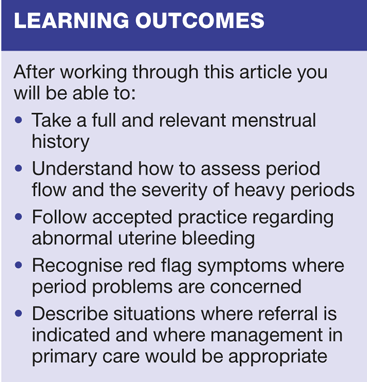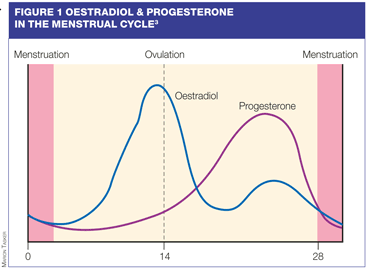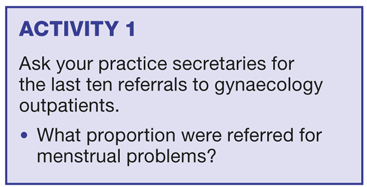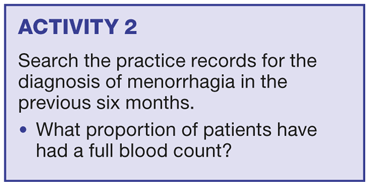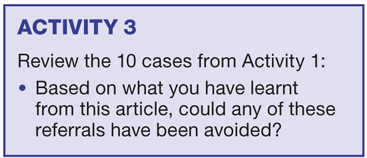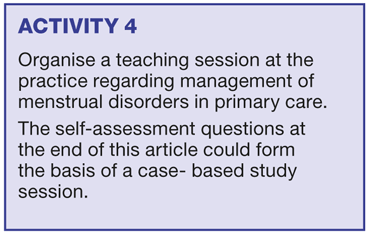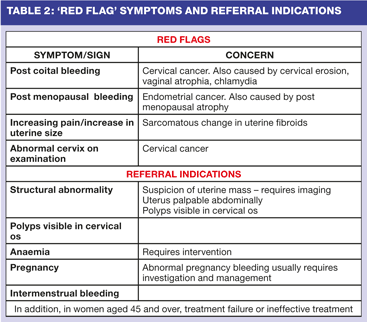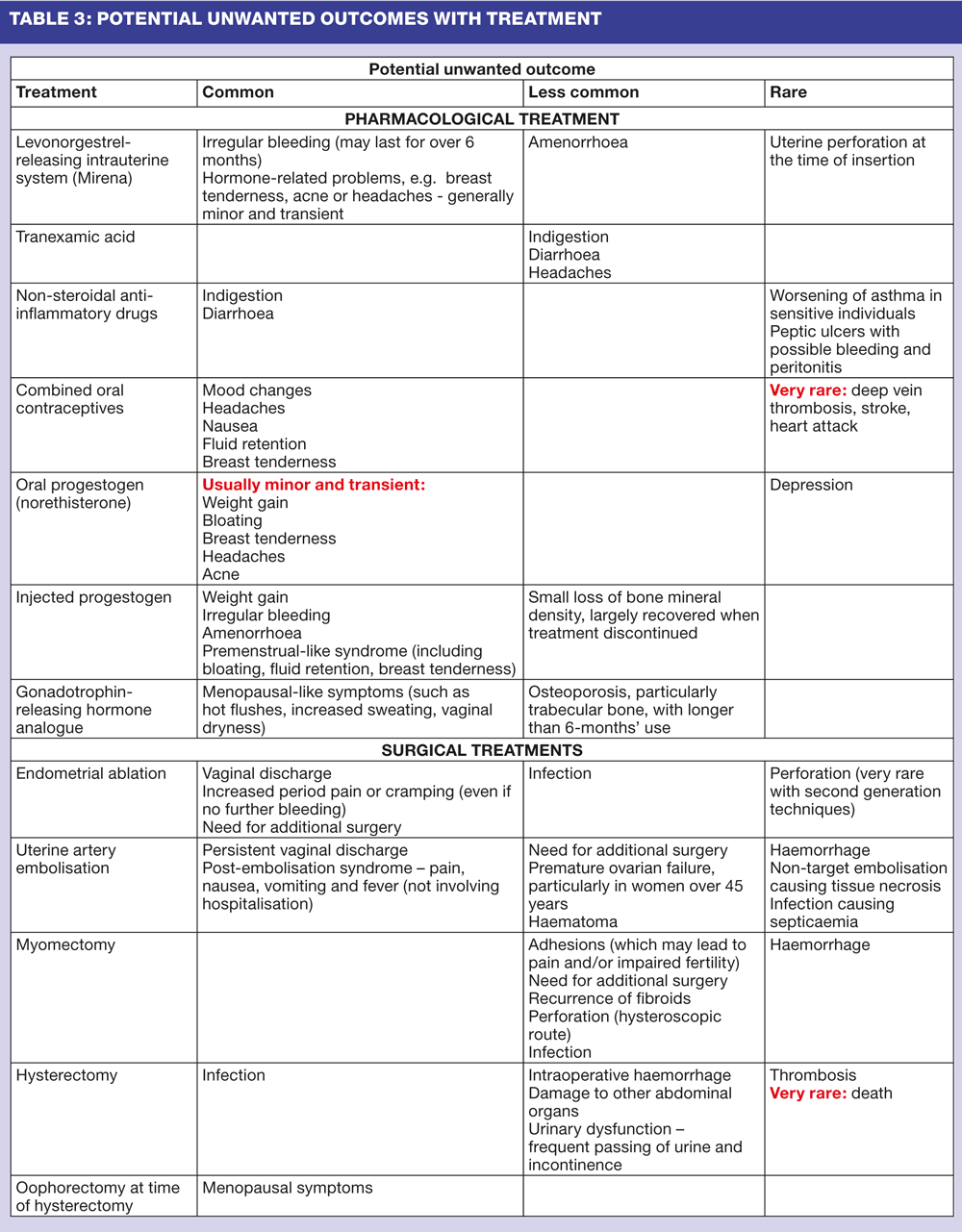Management of menstrual problems
Dr Mary Selby, MB BChir FRCGP PGCE DFFP DRCOG
Dr Mary Selby, MB BChir FRCGP PGCE DFFP DRCOG
GP Locum and RCGP Examiner
The management of problem periods in general practice shows considerable variation and in some cases scope for improvement, but this can be a rewarding area for the advanced practice nurse
Women frequently consult in primary care regarding their periods, but there is substantial variation between practices in their approach to prescribing, investigation and referral, with scope for improvement.1 Most problems involve quantity, frequency, regularity or pain. Of these, heavy menstrual bleeding, with or without pain, presents most frequently.1 This article will cover menorrhagia, dysmenorrhoea, oligomenorrhoea and amenorrhoea, and will examine causes and management options, including current NICE guidance on heavy menstrual bleeding.2
CAUSES OF PERIOD PROBLEMS
These broadly relate to seven factors:
1. Expectations Young patients and women who stop oral contraception after many years may interpret normal periods as heavy. A clear understanding of what the patient wants and hopes for is important.
2. Normal hormone cycles Heavy, painful periods are most frequently associated with normal hormone measurements and normal cycles,3 but patients generally believe otherwise. If periods are regular it is likely that the hormone cycle is essentially normal.
3. Abnormal hormone cycles Anovulatory cycles and cycles with hormonal abnormality tend to produce irregular periods. These may be sparse (oligomenorrhoea), e.g. in polycystic ovarian syndrome, or overly frequent, as with anovulatory cycles early in menarche and approaching menopause.
4. Ovarian dysfunction Endometriosis, polycystic ovaries.
5. Structural abnormalities Structural abnormalities of the uterus, e.g. fibroids, cancer, may be associated with thickened muscle and engorged blood vessels which are more likely to bleed when the endometrium is being menstrually shed - and when it isn't.
6. Haematological abnormalities Clotting disorders increase bleeding volumes. Women with von Willebrands disease may present with heavy periods, although there is usually also a suggestive history of post operative and mucous membrane bleeding.
7. Sexually transmitted infections (STIs) STIs, e.g. chlamydia, don't usually affect periods directly but may cause discharge and/or post coital bleeding, and be interpreted as a period problem.
A few specific conditions are worthy of mention.
Endometriosis: Tissue from the lining of the womb (endometrium) implants on the ovaries, cervix, within the uterine wall or elsewhere. This ectopic tissue bleeds with every period, causing pain and scarring. The condition produces pelvic pain, pain on intercourse (dyspareunia), dysmenorrhoea and varying degrees of infertility.
Fibroids: Benign tumours of the muscle of the uterine wall enlarge the uterus and can cause heavy periods and pain. Examination reveals a bulky uterus, and fibroids are easily identified on ultrasound. They tend to worsen as menopause approaches and resolve after it.
Polycystic ovarian syndrome (PCOS): Multiple ovarian cysts, at an arrested stage of the cycle, produce high levels of androgenic hormones and the cycle does not progress. It is diagnosed in the presence of obesity, hirsutism and oligomenorrhoea, and is associated with diabetes and insulin resistance.
Painful periods in adolescence: Common in early menstrual life. Many nulliparous women experience cramping period pains associated with feelings of faintness, nausea and actual fainting. The theory is that a tightly closed cervical os may impede the flow of blood, making the passage of clots particularly painful. Some patients certainly experience a vasovagal response when the cervix is instrumented, and may have similar feelings when clots of blood traverse the cervical canal.
APPROACHING PROBLEM PERIODS
Consider a '5 step' approach.
1. Taking a menstrual history
Good history taking enables functional, focused consulting and helps gain the patient's confidence.4 The key elements are in Table 1 and 'Red Flag' symptoms and referral indications in Table 2.
2. Investigation of period problems
Patients often expect blood tests and imaging and NICE guidance2 suggests we should offer some investigations in any patient for whom imaging or referral are being considered. Box 1 shows the recommended lab tests in heavy menstrual bleeding. Hormone testing is rarely helpful in the diagnosis of period problems, except in investigation of specific hormonal issues, like PCOS, and assessment of infertility or amenorrhoea. Figure 1, the normal hormonal changes of the menstrual cycle,3 illustrates that all sorts of hormone levels are likely to be normal at different stages of the cycle. 'Spot' levels are a snapshot and most will be in the normal range. A cervical smear should be taken, if indicated or due. Period problems represent an opportunity for regular screening. High vaginal swab, chlamydia and gonorrhoea screening are indicated if infection is suspected.
3. Further investigations
Imaging is indicated if the uterus is palpable abdominally or if examination reveals a pelvic mass. Ultrasound is the first-line tool for identifying structural abnormalities. Beyond this, referral for endometrial biopsy, to exclude endometrial cancer or atypical hyperplasia (possible precancerous changes and thickening in the endometrium), will be necessary.
4. Pregnancy testing
Pregnancy should be considered as a cause of unexplained heavy bleeding or absence of periods. Patients often say they can't be pregnant when in fact they mean precautions were taken, at varying levels, and they do not believe they are pregnant. Clarify or you will look foolish!
5. Treatment
Broadly speaking there are three ways to tackle period problems:
1. Medication, which acts on the flow of blood, reducing bleeding directly. The most commonly used, tranexamic acid, reduces blood flow by about a third.
2. Hormonal treatments to control the cycle. This usually either involves using the contraceptive pill to regulate the cycle, or using hormones to suppress the cycle altogether. The levonorgestrel-releasing intrauterine system (LNG-IUS) (Mirena) has proved particularly useful for women who also need contraception.
3. Surgery, ranging from laser treatment to the uterine lining, to hysterectomy.
HEAVY PERIODS
Heavy menstrual bleeding is defined as excessive menstrual blood loss that interferes with a woman's physical, social, emotional and/or material quality of life.2 It is thus defined by its effect on the patient. There is no need to quantify how much blood loss is involved. Over 5% of women on a GP list will consult regarding heavy menstrual loss annually.1 Since higher referral rates result in higher operative rates there is much to be said for good management in primary care. In one study, 38% of women with heavy periods were referred to secondary care, of whom 43% had an operation, highlighting the need for gate-keeping in primary care.1 Heavy periods can cause significant disruption to life and may lead to marked anaemia and tiredness. Women consult about why their menstrual loss has changed.5 Some may just seek reassurance,6 while others want treatment or are concerned regarding fertility or possible sinister causes.
Assessment
The initial history should cover the nature of the bleeding, related symptoms that might suggest structural or histological abnormality (e.g. pelvic pain, post coital bleeding), how it affects the patient's life, the presence of co-morbidity, and wish to conceive or need for adequate contraception. If the history doesn't raise red flag or referral level concerns (Table 2), treatment can be started without a physical examination or other investigations, unless the treatment chosen is the Mirena-IUS, in which case pelvic examination is necessary.2 If the history suggests structural or histological abnormality, a physical examination should be carried out before proceeding to other investigations, such as ultrasound.
Investigations
Laboratory tests and imaging investigations are detailed in Box 1.2
When to refer
Women with large fibroids (palpable abdominally, fibroids in the uterine cavity or uterine length greater than 12 cm) should be offered referral.
Treatment
Treatment of heavy periods may be surgical or medical. Surgery is usually indicated in cases of proven pathology, for example, uterine fibroids. In cases where no structural or histological abnormality is present, or if fibroids are less than 3cm, NICE suggest that pharmacological treatment should be considered.
Pharmalogical management2
This should be considered in the following order:
- LNG-IUS, provided long-term (at least 12-months) use is anticipated. This is not ideal in young, nulliparous patients who often do not tolerate the fitting.
- Tranexamic acid, or non-steroidal anti-inflammatory drugs (NSAIDs), or combined oral contraceptives (COCs). Where there is also dysmenorrhoea NSAIDs are better than tranexamic acid.
- Norethisterone (15 mg daily) from days 5 to 26 of the menstrual cycle, or injected long-acting progestogens. If hormonal treatments are not acceptable to the woman, then either tranexamic acid or NSAIDs can be used.
Surgical treatment
Endometrial ablation, involving removal of the endometrial layer of the uterus, is widely available. It can be helpful to tell patients about this procedure.6 Suitable patients are those whose uterus is no bigger than a 10-week pregnancy. The majority have sparse or absent periods after this procedure, although contraception is still needed. It should be considered where bleeding is having a severe impact on a woman's quality of life, and she does not want to conceive in the future. Hysterectomy can be regarded as the final solution for heavy periods. The first line approach is vaginal and second line abdominal. Hysterectomy should be considered only when:
- Other treatment options have failed, are contraindicated or are declined by the woman
- There is a wish for amenorrhoea
- She is clear, after being fully informed, that it is what she really wants.
FIBROIDS
NICE offers particular guidance around the management of fibroids diagnosed on ultrasound.2 Small fibroids (3cm or less) may be managed with the LNG-IUS. Very large fibroids require referral for consideration of surgical or embolisation treatments. Sometimes gonadotrophin analogues such as Zoladex are used in an attempt to suppress fibroids. This is often a temporary measure prior to surgery since they cause menopausal side effects. The potential unwanted outcomes of all the various treatment options are shown in Table 3.
PAINFUL PERIODS (DYSMENORRHOEA)
In most women, menstruation is associated with some degree of pelvic discomfort. In half, menstruation is associated with pain, which often may not be limited to the menses. In about 10%, symptoms are severe enough to enforce bed rest. Affected women often do less well at school and take more days off work, so it is important to ask how the symptoms affect the patient's life. Primary dysmenorrhoea, painful menstruation in the absence of detectable pelvic pathology, generally starts a year or so after menarche, once ovulatory cycles are established. The peak incidence is between 15 and 25 years of age. Cramping pain in the lower abdomen may radiate to thighs and lower back. Pain usually begins about 24 hours before menstruation and persists for about 48 hours. It may be accompanied by nausea, vomiting and diarrhoea. Symptoms usually decrease with age. Secondary dysmenorrhoea, painful menstruation attributed to pelvic pathology, is uncommon before the age of 25 and may be associated with menorrhagia, dyspareunia or infertility. History should be particularly focussed on onset of dysmenorrhoea and relation to menses. Remember to ask if an intra-uterine contraceptive device is present (this may be the cause of the pain) and if the patient has pain on intercourse, heavy periods or has had difficulty conceiving. Endometriosis, which causes the triad of dysmenorrhoea, dyspareunia and infertility, can only be diagnosed reliably on laparoscopy, although the history may be very suggestive. A systematic review7 of factors predisposing women to chronic and recurrent pelvic pain found that it tends to be most prevalent in young women who smoke, and is associated with:
- Low BMI
- Early menarche
- Possible pelvic inflammatory disease (PID)
- Longer, heavier periods
- Sexual abuse
- Sterilisation
- Psychological problems. Many of these features might be expected to be associated with increased pain. Exercise, oral contraceptive use and having had children appear to be protective.
Examination
Examination - both bimanually and with the speculum - is important if there is dyspareunia, to rule out polyps protruding from the cervical os. Treatment NSAIDs, e.g. mefenamic acid, naproxen, and ibuprofen, reduce uterine contraction and are effective in 80-90% of cases. If periods are regular, treatment will be more effective if initiated one day before menstruation begins. COCs reduce menstrual flow and inhibit ovulation - which is generally associated with primary dysmenorrhoea. They will therefore often relieve primary dysmenorrhoea and are particularly useful where contraception is also required. Indeed, some teenagers may use painful periods as a means of obtaining a COC prescription. It is therefore important to give contraceptive use advice, even when prescribing for another indication. Alverine citrate (Spasmonal), an antispasmodic that relaxes uterine muscle, is licensed for treatment of dysmenorrhoea. There is little published evidence regarding its efficacy. If the above measures are ineffective then other treatments include the LNG-IUS and non-drug treatments such as transcutaneous electrical nerve stimulation (TENS).
IRREGULAR PERIODS
Oligomenorrhoea
Oligomenorrhoea is infrequent menstruation defined by a cycle length between 6 weeks and 6 months. Cycles may be ovulatory or anovulatory. Treatment is generally directed at the specific cause and is chosen by the patient's wish, or otherwise, to conceive. COCs will produce regular periods and suppresses PCOS, but if the patient wishes to conceive then referral to secondary care is needed for consideration of drugs that stimulate ovulation. The investigation of oligomenorrhoea in suspected PCOS involves endocrine tests and ovarian imaging and its management needs to involve the four aspects of the condition; irregular periods, infertility, hirsutism/acne and insulin resistance.
Amenorrhoea
Pathological amenorrhoea is the failure to menstruate for at least 6 months (or 6 cycles) during normal reproductive life, in the absence of pregnancy or lactation. Excluding pregnancy, about 20-30% of women experience amenorrhoea during reproductive life. The prevalence of amenorrhoea not due to pregnancy, lactation or menopause is estimated at 3-4%.8Amenorrhoea is generally a concern to patients because they fear (or want) pregnancy, or worry that some underlying condition has led to it. Pregnancy is easily ruled out or confirmed. A raised FSH and LH level may show menopause or premature menopause (below the age of 40). Other common causes of amenorrhea are weight loss, fitness training and distance running, all of which can affect the hormone cycle, causing temporary ovarian shutdown, cessation of periods and, probably, infertility. The return of fertility and the return of periods are generally the same thing. Worried women should be encouraged to eat sensibly and moderate their fitness training away from extremes to encourage return to normal function. Prolonged amenorrhea is associated with considerably increased osteoporosis risk, and women should be advised accordingly.
POSTPONING MENSTRUATION
This can be achieved with norethisterone 5mg three times daily, starting 3 days before the anticipated onset of menstruation. If patients don't know when the period is due, it should be started three days before amenorrhea is needed. If the period starts it will go away again. Menstruation will occur 2-3 days after stopping the norethisterone. Norethisterone comes in packs of 30, which will postpone the period for 10 days. Two packs at a time is often successful, but more than this and there is a significant chance that there will be some breakthrough vaginal bleeding anyway. It's important to remind patients that this is not a contraceptive. If they are on the COC then running two packets together will achieve the same effect. Triphasic pills need special advice in this respect. They will need to take the last phase of the pills from the second pack immediately after finishing the first pack.9
CONCLUSION
Greater knowledge and insight in the area of period problems can help the practice nurse manage many patients who might otherwise need referral. Confidence in one's own knowledge, plus good consultation skills, are vital in order to avoid unnecessary visits to secondary care.
REFERENCES
1. Grant C, Gallier L, Faheya T, et al. Management of menorrhagia in primary care-impact on referral and hysterectomy: data from the Somerset Morbidity project. Journal of Epidemiology and Community Health 2000; 54: 709-713 doi:10.1136/jech.54.9.709
2. National Institute for Health and Clinical Excellence. Heavy Menstrual Bleeding. Clinical guideline 44. 2007. http://www.nice.org.uk/nicemedia/live/11002/30404/30404.pdf
3. GP notebook: normal menstrual cycle: http://www.gpnotebook.co.uk/simplepage.cfm?ID=-2060124083&linkID=53184&cook=yes
4. Patient Plus on patient.co.uk. Consultation Analysis http://www.patient.co.uk/doctor/Consultation-Analysis.htm
5. O'Flynn N, Britten N. Menorrhagia in general practice- disease or illness. Social Science Medicine 2000; 50:651-661.
6. Royal College of Obstetricians and Gynaecologists. The initial management of menorrhagia. London. RCOG Press. 1998
7. Latthe P, Mignini L, Gray R et al. Factors predisposing women to chronic pelvic pain: systematic review. BMJ 2006; 332(7544): 749-55.
8. Practice Committee of the American Society for Reproductive Medicine. Current evaluation of amenorrhea. Fertility and Sterility 2008; 90(5 Suppl): S219-S225.
9. Periods: how to delay one - advice for patients on www.patient.co.uk : http://www.patient.co.uk/health/Periods-How-to-Delay-One.htm
Related articles
View all Articles

